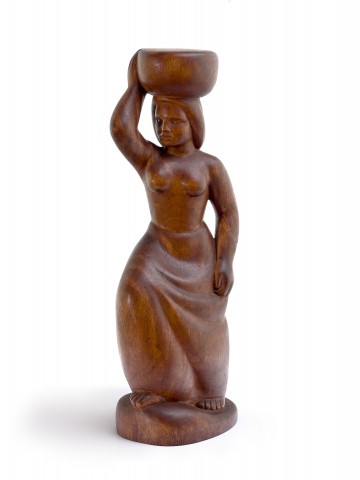WOMAN, ALSO KNOWN AS WOMAN CARRYING BASKET, 1938
MARGEL HINDER
New Guinea wood
50.0 x 15.0 x 17.0 cm
Robert Klippel, Sydney, acquired directly from the artist
Private collection, Sydney
Frank and Margel Hinder Retrospective, Newcastle City Art Gallery, New South Wales, 30 August – 30 September 1973, cat. 2
Five Decades: Frank Hinder, Paintings, Margel Hinder, Sculptures, Gallery A, Sydney, 7 – 28 June 1980, cat. 1 (as ‘Woman Carrying Basket’)
Margel Hinder: Modern in Motion, Art Gallery of New South Wales, Sydney, 30 January – 2 May 2021 and Heide Museum of Modern Art, Melbourne, 30 June – 10 October 2021, cat. 5
Cornford, I., The Sculpture of Margel Hinder, Phillip Matthews Book Publishers, Sydney, 2013, p. 40 (as ‘Woman Carrying Basket’)
Harding, L., and Mimmocchi, D., (ed.), Margel Hinder: Modern in Motion, Art Gallery of New South Wales, Sydney and Heide Museum of Modern Art, Melbourne, 2021, pp. 116 (illus.), 178
American-born sculptor Margel Hinder cut a unique figure in the modern art scene of Sydney when she arrived on the S. S. City of Rayville, beside her husband Frank, in July 1934. Having had a privileged middle-class upbringing particularly supportive of artistic pursuits, the young Hinder was devotee of the modernist and theosophic theories of Vitalism and Dynamic Symmetry, encountered through the teachings of Howard Giles and Emil Bisttram. Both Margel and Frank followed Bisttram to Taos, New Mexico, to participate in his experimental summer school in 1933. This sojourn proved to be formative experiences for both artists, informing their adoption of geometric abstraction and introducing them to the revolutionary social realism of the Mexican New Order (Bisttram having studied mural painting alongside Diego Riviera). Applying these concepts to wood carvings upon her return to Australia, Hinder demonstrates a strong influence of these artists, whose teachings she shared keenly with her new artist friends.
Although Hinder had been disappointed by Australia’s retrograde notions of modern art and continuously fought against the ‘little understanding of, or desire for the three-dimensional’,1, by the close of the 1930s, she encountered like-minded internationally engaged artists in the George Street studio of the Crowley-Fizelle School. Margo and Gerald Lewers in particular, provided tutelage in carving and deepened Hinder’s awareness of the precept of ‘truth-to-materials’ and ‘purified forms’, as advocated Henry Moore and Barbara Hepworth, whom the Lewers had recently met in England.2
Woman, or Woman Carrying Basket, is a simple character study of a woman at work, carved directly from a block of New Guinean hardwood. 3 This sculpture belongs to a small group of figurative works, carved in relief panels or in freestanding forms, local tableaux of work and rural lifestyle, inspired by the local Pueblo women of Taos. The Hinders’ fascination with this first nations community was founded on an admiration for their traditional way of life, considered to be an ancient and unadulterated connection to the land and its natural cycles. Hinder carved the first of these works, Taos Women, during her long boat journey back to Australia, quickly followed by a freestanding figure, Pueblo Indian. Characterized by simplified blocky forms, the governing geometry of these sculptures attempted to convey the movements and inner metaphysical life forces of her subjects.
Woman is a later harmonious and resolved synthesis of these diverse artistic and philosophical theories from Taos. Carrying a basket on her head in the same pose that can be seen in both Taos Women and Pueblo Indian, the heavy rounded forms of Woman are elegantly carved, with forms blending imperceptibly in the smooth surface. Hinder’s anonymous woman is proud, her striding stance determined in its progress, the rhythmic folds of her skirt reinforcing the directing lines of her upheld arm. Romanticizing manual labour and social enterprise with an archetypal and easily legible figurative form, Woman becomes a robust and idealized example of physical vitality.
In the face of institutional disdain for sculpture, and systemic sexism, Margel Hinder became an extraordinarily successful artist. At a time where modelling was the preferred form of sculpture, Hinder created opportunities for herself to be on the forefront of progressive practice, becoming ‘an excellent example of a modern woman who can successfully combine a career and the running of a home’.4
1. Hinder, M., ‘A Personal view. 1930 – 1940’, Australian Women Artists. One Hundred Year 1840 – 1940, Melbourne University Union, Melbourne, 1975, p. 19
2. Harding, L., and Mimmocchi, D., (ed.), Margel Hinder: Modern in Motion, Art Gallery of New South Wales, Sydney and Heide Museum of Modern Art, Melbourne, 2021, p. 39
3. ‘“the harder the wood the more pleasure there is in the work”. Most of the wood Mrs. Hinder uses is sent from a plantation in New Guinea’, Page, M., ‘She Sculptures in Wood’, Sydney Morning Herald, Sydney, 13 November 1939, p. 2
4. Page, M., ibid
LUCIE REEVES-SMITH
